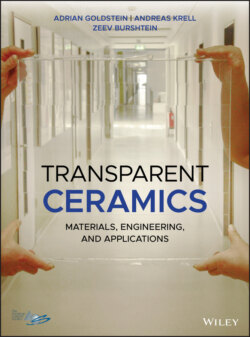Читать книгу Transparent Ceramics - Adrian Goldstein - Страница 24
1.5.2 The First Fully Crystalline Transparent Ceramic
ОглавлениеGeneral Electric's research department has developed a fully dense polycrystalline alpha-alumina α-Al2O3 product named Lucalox (acronym for translucent aluminum oxide), exhibiting a high (mostly diffusive) TFT, together with a significant in-line transmittance, for less than approximately 1.5 mm thickness. This development demonstrates a good example of synergy between ceramic and engineering sciences [B66, C2, C39]. The latter contributed a highly pure, only slightly agglomerated submicron raw material. As opposed to most alumina powders of that time, it was based on quite isometric particles. It has also been observed that very small additions of magnesium oxide MgO could promote sintering densification and eliminate or reduce the fraction of excessively large grains in the sintered product. Regarding ceramic science, the Lucalox development occurred in a period when modern understanding of sintering made a huge leap forward. Some of the luminaries of sintering theory, first and foremost R. L. Coble, were directly involved in the Lucalox saga. Combining experimental observations (some made by chance) with suggested sintering models, the developers concluded that (i) intra-grain occlusion massively stabilized pores; (ii) occlusion is favored by grain growth, especially its “abnormal” variety; (iii) abnormal grain growth may be reduced by suitable dopants (that control, probably selectively, grain boundary mobility); and (iv) magnesium oxide MgO was the most efficient such additive. Work started around 1956 and by 1959 led to the eventual achievement of a pore-free, highly translucent alumina, such as that shown in Figure 1.4.
Compared to fused silica, the Lucalox product at that time combined a very reasonable transmittance with excellent refractoriness, reasonable resistance to thermal shock, and enhanced resistance to chemical attack by high pressured sodium Na vapor at ∼1200 °C. The Lucalox allowed the design of streetlamps, based on the fluorescence of high pressure sodium oxide NaO vapor. The high pressure and temperature – allowed by alumina but not the silica containers – conferred to the lamps exceptional luminosity, up to about 100 Lm/W. This device (Figure 1.5), the first to include transparent ceramic as a key component, was marketed in 1966 and achieved great commercial success. By 1990, some US$500 million worth of such lamps were sold.
The advent of the Lucalox, and then its commercial success, immediately triggered great interest in transparent ceramics. New materials and processing approaches, along with considerable basic knowledge, resulted in efforts to develop new transparent ceramics.
Figure 1.4 First translucent, all-crystalline ceramic: imaging and microstructure (a) White opaque regular alumina ceramic (left) translucent “Lucalox” (GE) ceramic alumina (right) and (b) microstructure (center grain = 95 micron) of translucent part shown above.
